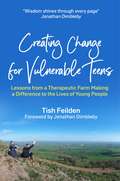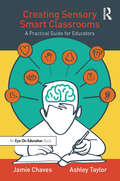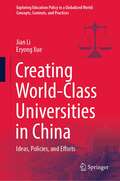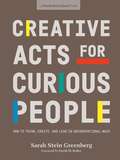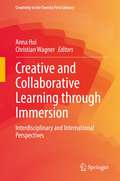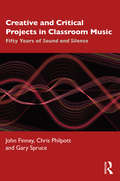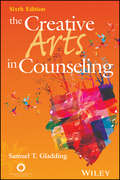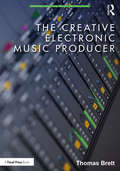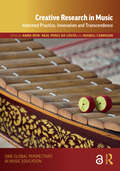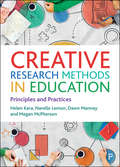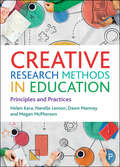- Table View
- List View
Creating Change for Vulnerable Teens: Lessons from a Therapeutic Farm Making a Difference to the Lives of Young People
by Tish FeildenCreating Change for Vulnerable Teens tells the story of Tish Feilden and Jamie's Farm - a network of therapeutic farms dedicated to transforming the lives of disadvantaged children.Documenting Tish's experiences of working with truly remarkable teens who have faced huge challenges in their lives, the book describes how the farms help young people to thrive academically, socially and emotionally. She shares the approaches they have pioneered, including the critical importance of trust, of looking behind the behaviour and of really connecting with the desires and hopes of young people. If you have an interest in supporting vulnerable children or young people, this book provides a wealth of inspiration and ideas you can use, whatever the setting.
Creating Inclusive Writing Environments in the K-12 Classroom: Reluctance, Resistance, and Strategies that Make a Difference
by Angela StockmanTimely and accessible, this book offers tangible strategies that will help teachers plan and sustain writing workshop experiences that are responsive to the needs of their specific students. Angela Stockman helps teachers understand why some writers may fail to meet their expectations and how to help all writers reach their fullest potential. Organized in three parts, this book reframes common narratives about resistant writers, empowers teachers to design, lead and refine their workshop, and provides a toolkit to do so. The appendices and eResources included provide teachers with instructions for mini-lessons and learning targets that support multimodal composition, perfect for pre-service and in-service teachers.
Creating Inclusive Writing Environments in the K-12 Classroom: Reluctance, Resistance, and Strategies that Make a Difference
by Angela StockmanTimely and accessible, this book offers tangible strategies that will help teachers plan and sustain writing workshop experiences that are responsive to the needs of their specific students. Angela Stockman helps teachers understand why some writers may fail to meet their expectations and how to help all writers reach their fullest potential. Organized in three parts, this book reframes common narratives about resistant writers, empowers teachers to design, lead and refine their workshop, and provides a toolkit to do so. The appendices and eResources included provide teachers with instructions for mini-lessons and learning targets that support multimodal composition, perfect for pre-service and in-service teachers.
Creating Sensory Smart Classrooms: A Practical Guide for Educators
by Jamie Chaves Ashley TaylorCreating Sensory Smart Classrooms introduces educators to the foundations of sensory processing and offers tools to meet the wide variety of sensory needs in each classroom. This comprehensive handbook helps readers understand the neurobiology behind sensory processing and regulation issues, recognize when a student is over- or under-stimulated, and integrate different sensory inputs into the school environment. Practical and accessible chapters foster an understanding of how sensory processing influences behaviors in the classroom and how protective relationships, combined with sensory strategies, positively influence students' regulation for improved learning outcomes. Packed with useful examples, this is essential reading for teachers looking to develop the knowledge and skills they need to design sensory smart environments that support ALL learners.
Creating Sensory Smart Classrooms: A Practical Guide for Educators
by Jamie Chaves Ashley TaylorCreating Sensory Smart Classrooms introduces educators to the foundations of sensory processing and offers tools to meet the wide variety of sensory needs in each classroom. This comprehensive handbook helps readers understand the neurobiology behind sensory processing and regulation issues, recognize when a student is over- or under-stimulated, and integrate different sensory inputs into the school environment. Practical and accessible chapters foster an understanding of how sensory processing influences behaviors in the classroom and how protective relationships, combined with sensory strategies, positively influence students' regulation for improved learning outcomes. Packed with useful examples, this is essential reading for teachers looking to develop the knowledge and skills they need to design sensory smart environments that support ALL learners.
Creating Spaces of Wellbeing and Belonging for Refugee and Asylum-Seeker Students: Skills and Strategies for School Leaders
by Scott Imig Maura Sellars John FischettiThis practical resource for principals and school leaders provides guidance on how to develop schools into places of belonging for all children, especially children of refugee and asylum-seeker backgrounds. It demonstrates the need for school leaders to be informed, reflective individuals and highlights the role that leaders can play in a school culture that provides a safe place and effective educational opportunities for these students. Written in an accessible manner, each chapter includes a summary of theory and vignettes from school leaders that outline approaches, challenges, critical reflections and suggestions for how their experiences can be adapted to other contexts. Principals' voices and experiences from across the globe are included, representing a range of school levels including primary and secondary, large and small enrolments, religious and public, and urban and rural settings. This book is intended for use in schools by school principals and aspiring school leaders, and by educational professionals engaged in supporting schools with students with refugee backgrounds.
Creating Spaces of Wellbeing and Belonging for Refugee and Asylum-Seeker Students: Skills and Strategies for School Leaders
by Scott Imig Maura Sellars John FischettiThis practical resource for principals and school leaders provides guidance on how to develop schools into places of belonging for all children, especially children of refugee and asylum-seeker backgrounds. It demonstrates the need for school leaders to be informed, reflective individuals and highlights the role that leaders can play in a school culture that provides a safe place and effective educational opportunities for these students. Written in an accessible manner, each chapter includes a summary of theory and vignettes from school leaders that outline approaches, challenges, critical reflections and suggestions for how their experiences can be adapted to other contexts. Principals' voices and experiences from across the globe are included, representing a range of school levels including primary and secondary, large and small enrolments, religious and public, and urban and rural settings. This book is intended for use in schools by school principals and aspiring school leaders, and by educational professionals engaged in supporting schools with students with refugee backgrounds.
Creating Sustainable Careers in Student Affairs: What Ideal Worker Norms Get Wrong and How to Make It Right
by Margaret W. Sallee, Kristen A. RennThis book argues that the current structure of student affairs work is not sustainable, as it depends on the notion that employees are available to work non-stop without any outside responsibilities, that is, the Ideal Worker Norm. The field places inordinate burdens on staff to respond to the needs of students, often at the expense of their own families and well-being. Student affairs professionals can meet the needs of their students without being overworked. The problem, however, is that ideal worker norms pervade higher education and student affairs work, thus providing little incentive for institutions to change. The authors in this book use ideal worker norms in conjunction with other theories to interrogate the impact on student affairs staff across functional areas, institutional types, career stage, and identity groups. The book is divided into three sections; chapters in the first section of the book examine various facets of the structure of work in student affairs, including the impact of institutional type and different functional areas on employees’ work-lives. Chapters in the second section examine the personal toll that working in student affairs can take, including emotional labor’s impact on well-being. The final section of the book narrows the focus to explore how different identity groups, including mothers, fathers, and people of color, navigate work/life issues. Challenging ideal worker norms, all chapters offer implications for practice for both individuals and institutions.
Creating Sustainable Careers in Student Affairs: What Ideal Worker Norms Get Wrong and How to Make It Right
This book argues that the current structure of student affairs work is not sustainable, as it depends on the notion that employees are available to work non-stop without any outside responsibilities, that is, the Ideal Worker Norm. The field places inordinate burdens on staff to respond to the needs of students, often at the expense of their own families and well-being. Student affairs professionals can meet the needs of their students without being overworked. The problem, however, is that ideal worker norms pervade higher education and student affairs work, thus providing little incentive for institutions to change. The authors in this book use ideal worker norms in conjunction with other theories to interrogate the impact on student affairs staff across functional areas, institutional types, career stage, and identity groups. The book is divided into three sections; chapters in the first section of the book examine various facets of the structure of work in student affairs, including the impact of institutional type and different functional areas on employees’ work-lives. Chapters in the second section examine the personal toll that working in student affairs can take, including emotional labor’s impact on well-being. The final section of the book narrows the focus to explore how different identity groups, including mothers, fathers, and people of color, navigate work/life issues. Challenging ideal worker norms, all chapters offer implications for practice for both individuals and institutions.
Creating Transformative Online Communities in Higher Education
by Patrick R. DempseyCreating Transformative Online Communities in Higher Education provides a practical approach for building authentic learning experiences into the design and delivery of online teaching and learning systems. Combining three conceptually related ideas—complexity theory, transformative learning, and the Community of Inquiry—this novel, highly applicable framework enables instructors to create compelling virtual learning experiences for students. As higher education faculty, instructional designers, and graduate students shift from presenting information to creating experiences, the book offers an evidence-based disruption of the current thinking on and practice of course design.
Creating Transformative Online Communities in Higher Education
by Patrick R. DempseyCreating Transformative Online Communities in Higher Education provides a practical approach for building authentic learning experiences into the design and delivery of online teaching and learning systems. Combining three conceptually related ideas—complexity theory, transformative learning, and the Community of Inquiry—this novel, highly applicable framework enables instructors to create compelling virtual learning experiences for students. As higher education faculty, instructional designers, and graduate students shift from presenting information to creating experiences, the book offers an evidence-based disruption of the current thinking on and practice of course design.
Creating World-Class Universities in China: Ideas, Policies, and Efforts (Exploring Education Policy in a Globalized World: Concepts, Contexts, and Practices)
by Jian Li Eryong XueThis book explores how can we shape “World-class University” in China from the perspectives of ideas, policies and efforts, specifically. It examines the essence and logic of creating world-class universities and disciplines and focuses on the construction of a number of universities and disciplines across a number of historical periods. The book also investigates the improvement of China's education, and the higher education needs to “face modernization, face the world, face the future”. It offers a broader vision to connect with the Chinese higher education system and the international higher education communities contextually.
Creative Acts For Curious People: How to Think, Create, and Lead in Unconventional Ways
by Sarah Stein Greenberg'Packed end to end with ways to see the world in new ways' Mike Krieger, cofounder, Instagram 'Designed to spark creativity, help solve problems, foster connection and make our lives better' Gretchen Rubin'Navigate today's world with agility, resilience and imagination' Lorraine Twohill, CMO, GoogleWhat do they teach you at the most prestigious design school in the world? For the first time, you can find out. This highly-visual guide brings to life the philosophies of some of the d.school's most inventive and unconventional minds, including founder David Kelley, Choreographer Aleta Hayes and Google Chief Innovation Evangelist Frederik Pferdt and more. Creative Acts for Curious People is packed with ideas about the art of learning, discovery and leading through creative problem solving. With exercises including:- 'Expert Eyes' to test your observation skills- 'How to Talk to Strangers' to foster understanding- 'Designing Tools for Teams' to build creative leadershipRevealing the hidden dynamics of design, and delving inside the minds of the profession's most celebrated thought-leaders, this definitive guide will help you live up to your creative potential.
Creative Agency (Palgrave Studies in Creativity and Culture)
by Dan HarrisThis book offers a socio-cultural examination of contemporary creativity studies. Drawing heavily on posthumanist, new materialist and affective theoretics, the author argues in favour of an expansive and sustainable approach to creativity which contributes to an emergent ‘creativity studies’ inter-discipline. It seeks to establish a broader consideration of creativity in socio-culture, that extends beyond, or indeed refutes, the narrowing aperture of entrepreneurship and innovation as synonyms for creativity in economic, cultural and educational contexts and discourses. Drawing on multiple case studies of creative relational and creative ecological empirical research, this book integrates a concern for personal, planetary and geo-political collaboration, as an antidote for ‘innovation for innovation’s sake’.
Creative and Collaborative Learning through Immersion: Interdisciplinary and International Perspectives (Creativity in the Twenty First Century)
by Anna Hui Christian WagnerThis book includes instructional design and practice of how immersive technology is integrated in discipline-based and interdisciplinary curriculum design. It focuses on pedagogical models and learning outcomes of immersive learning experiences and demonstrates how immersive learning can be applied in industries. This book brings scholars, researchers and educators together around an international and interdisciplinary consolidation and reflection on learning through immersion. The originality lies in how advanced technology and contemporary pedagogical models can integrate to enhance student engagement and learning effectiveness in higher education.
Creative and Critical Projects in Classroom Music: Fifty Years of Sound and Silence
by John Finney Chris Philpott Gary SpruceCreative and Critical Projects in Classroom Music is both a celebration and extension of John Paynter and Peter Aston’s groundbreaking work on creative classroom music, Sound and Silence, first published in 1970. Building on the central themes of the original work – the child as artist, the role of musical imagination and creativity, and the process of making music – the authors and contributors provide a contemporary response to the spirit and style of Sound and Silence. They offer reflections on the ideas and convictions underpinning Paynter and Aston’s work in light of scholarship developed during the intervening years. This critical work is accompanied by 16 creative classroom projects designed and enacted by contemporary practitioners, raising questions about the nature and function of music in education and society. In summary, this book aims to: Celebrate seminal work on musical creativity in the classroom. Promote the integration of practical, critical and analytical writing and thinking around this key theme for music education. Contribute to initiating the next 50 years of thought in relation to music creativity in the classroom. Offering a unique combination of critical scholarship and practical application, and published on the occasion of the 50th anniversary of Sound and Silence, themes from Paynter and Aston’s work are here given fresh context that aims to inspire a new generation of innovative classroom practice and to challenge current ways of thinking about the music classroom.
Creative and Critical Projects in Classroom Music: Fifty Years of Sound and Silence
by John Finney Chris Philpott Gary SpruceCreative and Critical Projects in Classroom Music is both a celebration and extension of John Paynter and Peter Aston’s groundbreaking work on creative classroom music, Sound and Silence, first published in 1970. Building on the central themes of the original work – the child as artist, the role of musical imagination and creativity, and the process of making music – the authors and contributors provide a contemporary response to the spirit and style of Sound and Silence. They offer reflections on the ideas and convictions underpinning Paynter and Aston’s work in light of scholarship developed during the intervening years. This critical work is accompanied by 16 creative classroom projects designed and enacted by contemporary practitioners, raising questions about the nature and function of music in education and society. In summary, this book aims to: Celebrate seminal work on musical creativity in the classroom. Promote the integration of practical, critical and analytical writing and thinking around this key theme for music education. Contribute to initiating the next 50 years of thought in relation to music creativity in the classroom. Offering a unique combination of critical scholarship and practical application, and published on the occasion of the 50th anniversary of Sound and Silence, themes from Paynter and Aston’s work are here given fresh context that aims to inspire a new generation of innovative classroom practice and to challenge current ways of thinking about the music classroom.
The Creative Arts in Counseling
by Samuel T. GladdingThe Creative Arts in Counseling presents an evidence-based exploration of how expressive therapies can be used effectively with clients of all ages and backgrounds. After an introduction to the history and benefits of using the arts in counseling, Dr. Gladding discusses the therapeutic use of music; dance/movement; imagery; visual arts; writing/literature; drama; humor; play; animal-assisted therapy; and horticulture, nature, and wilderness therapies. Text features include a new section on incorporating the creative arts in telebehavioral counseling, two-part chapter overviews, 96 creative reflections for self-discovery, 145 exercises for use in session, and a listing of creative arts and art therapies websites. *Requests for digital versions from ACA can be found on www.wiley.com *To purchase print copies, please visit the ACA website here *Reproduction requests for material from books published by ACA should be directed to permissions@counseling.org
The Creative Arts in Counseling: The Creative Arts In Counseling
by Samuel T. GladdingThe Creative Arts in Counseling presents an evidence-based exploration of how expressive therapies can be used effectively with clients of all ages and backgrounds. After an introduction to the history and benefits of using the arts in counseling, Dr. Gladding discusses the therapeutic use of music; dance/movement; imagery; visual arts; writing/literature; drama; humor; play; animal-assisted therapy; and horticulture, nature, and wilderness therapies. Text features include a new section on incorporating the creative arts in telebehavioral counseling, two-part chapter overviews, 96 creative reflections for self-discovery, 145 exercises for use in session, and a listing of creative arts and art therapies websites. *Requests for digital versions from ACA can be found on www.wiley.com *To purchase print copies, please visit the ACA website here *Reproduction requests for material from books published by ACA should be directed to permissions@counseling.org
The Creative Electronic Music Producer (Perspectives on Music Production)
by Thomas BrettThe Creative Electronic Music Producer examines the creative processes of electronic music production, from idea discovery and perception to the power of improvising, editing, effects processing,sound design. Featuring case studies from across the globe on musical systems and workflows used in the production process, this book highlights how to pursue creative breakthroughs through exploration, trial and error tinkering, recombination, and transformation.The Creative Electronic Music Producer maps production's enchanting pathways in a way that will fascinate and inspire students of electronic music production, professionals already working in the industry, and hobbyists.
The Creative Electronic Music Producer (Perspectives on Music Production)
by Thomas BrettThe Creative Electronic Music Producer examines the creative processes of electronic music production, from idea discovery and perception to the power of improvising, editing, effects processing,sound design. Featuring case studies from across the globe on musical systems and workflows used in the production process, this book highlights how to pursue creative breakthroughs through exploration, trial and error tinkering, recombination, and transformation.The Creative Electronic Music Producer maps production's enchanting pathways in a way that will fascinate and inspire students of electronic music production, professionals already working in the industry, and hobbyists.
Creative Research in Music: Informed Practice, Innovation and Transcendence (ISME Series in Music Education)
by Anna Reid Neal Peres Da Costa Jeanell CarriganCreative Research in Music explores what it means to be an artistic researcher in music in the twenty-first century. The book delineates the myriad processes that underpin successful artistic research in music, providing best practice exemplars ranging from Western classical art to local indigenous traditions, and from small to large-scale, multi-media and cross-cultural work formats. Drawing on the richness of creative research work at key institutions in South-East Asia and Australian, this book examines the social, political, historical and cultural driving forces that spur and inspire excellence in creative research to extend and to cross boundaries, to sustain our music industry, to advocate for the importance of music in our world, and to make it clear that music matters.In the chapters, our authors present the ideas of informed practice, innovation and transcendence from diverse international perspectives. Each of these three themes has an introductory section where the theme is explored and the chapters in that section introduced. Taken as a whole, the book discusses how the themes in combination, with reference to the authorial group, are able to transform music pedagogy and performance for our global and complex world.Chapter 9 of this book is freely available as a downloadable Open Access PDF at http://www.taylorfrancis.com under a Creative Commons Attribution-Non Commercial-No Derivatives (CC-BY-NC-ND) 4.0 license.
Creative Research in Music: Informed Practice, Innovation and Transcendence (ISME Series in Music Education)
by Anna Reid Costa, Neal Peres Da Jeanell CarriganCreative Research in Music explores what it means to be an artistic researcher in music in the twenty-first century. The book delineates the myriad processes that underpin successful artistic research in music, providing best practice exemplars ranging from Western classical art to local indigenous traditions, and from small to large-scale, multi-media and cross-cultural work formats. Drawing on the richness of creative research work at key institutions in South-East Asia and Australian, this book examines the social, political, historical and cultural driving forces that spur and inspire excellence in creative research to extend and to cross boundaries, to sustain our music industry, to advocate for the importance of music in our world, and to make it clear that music matters.In the chapters, our authors present the ideas of informed practice, innovation and transcendence from diverse international perspectives. Each of these three themes has an introductory section where the theme is explored and the chapters in that section introduced. Taken as a whole, the book discusses how the themes in combination, with reference to the authorial group, are able to transform music pedagogy and performance for our global and complex world.Chapter 9 of this book is freely available as a downloadable Open Access PDF at http://www.taylorfrancis.com under a Creative Commons Attribution-Non Commercial-No Derivatives (CC-BY-NC-ND) 4.0 license.
Creative Research Methods in Education: Principles and Practices
by Helen Kara Narelle LemonCo-authored by an international team of experts across disciplines, this important book is one of the first to demonstrate the enormous benefit creative methods offer for education research. You do not have to be an artist to be creative, and the book encourages students, researchers and practitioners to discover and consider new ways to explore the field of education. It illustrates how using creative methods, such as poetic inquiry, comics, theatre and animation, can support learning and illuminate participation and engagement. Bridging academia and practice, the book offers: • practical advice and tips on how to use creative methods in education research; • numerous case studies from around the world providing real-life examples of creative research methods in education practice; • reflective discussion questions to support learning.
Creative Research Methods in Education: Principles and Practices
by Helen Kara Narelle LemonCo-authored by an international team of experts across disciplines, this important book is one of the first to demonstrate the enormous benefit creative methods offer for education research. You do not have to be an artist to be creative, and the book encourages students, researchers and practitioners to discover and consider new ways to explore the field of education. It illustrates how using creative methods, such as poetic inquiry, comics, theatre and animation, can support learning and illuminate participation and engagement. Bridging academia and practice, the book offers: • practical advice and tips on how to use creative methods in education research; • numerous case studies from around the world providing real-life examples of creative research methods in education practice; • reflective discussion questions to support learning.
